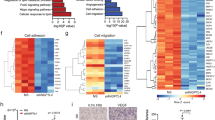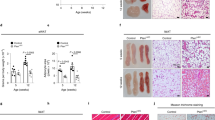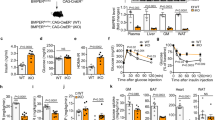Abstract
The vascular endothelial growth factors (VEGFs) are major angiogenic regulators and are involved in several aspects of endothelial cell physiology1. However, the detailed role of VEGF-B in blood vessel function has remained unclear2,3. Here we show that VEGF-B has an unexpected role in endothelial targeting of lipids to peripheral tissues. Dietary lipids present in circulation have to be transported through the vascular endothelium to be metabolized by tissue cells, a mechanism that is poorly understood4. Bioinformatic analysis showed that Vegfb was tightly co-expressed with nuclear-encoded mitochondrial genes across a large variety of physiological conditions in mice, pointing to a role for VEGF-B in metabolism. VEGF-B specifically controlled endothelial uptake of fatty acids via transcriptional regulation of vascular fatty acid transport proteins. As a consequence, Vegfb-/- mice showed less uptake and accumulation of lipids in muscle, heart and brown adipose tissue, and instead shunted lipids to white adipose tissue. This regulation was mediated by VEGF receptor 1 and neuropilin 1 expressed by the endothelium. The co-expression of VEGF-B and mitochondrial proteins introduces a novel regulatory mechanism, whereby endothelial lipid uptake and mitochondrial lipid use are tightly coordinated. The involvement of VEGF-B in lipid uptake may open up the possibility for novel strategies to modulate pathological lipid accumulation in diabetes, obesity and cardiovascular diseases.
This is a preview of subscription content, access via your institution
Access options
Subscribe to this journal
Receive 51 print issues and online access
$199.00 per year
only $3.90 per issue
Buy this article
- Purchase on Springer Link
- Instant access to full article PDF
Prices may be subject to local taxes which are calculated during checkout




Similar content being viewed by others
References
Tammela, T., Enholm, B., Alitalo, K. & Paavonen, K. The biology of vascular endothelial growth factors. Cardiovasc. Res. 65, 550–563 (2005)
Aase, K. et al. Vascular endothelial growth factor-B-deficient mice display an atrial conduction defect. Circulation 104, 358–364 (2001)
Bellomo, D. et al. Mice lacking the vascular endothelial growth factor-B gene (Vegfb) have smaller hearts, dysfunctional coronary vasculature, and impaired recovery from cardiac ischemia. Circ. Res. 86, E29–E35 (2000)
van der Vusse, G. J., van Bilsen, M. & Glatz, J. F. Cardiac fatty acid uptake and transport in health and disease. Cardiovasc. Res. 45, 279–293 (2000)
Clauss, M. et al. The vascular endothelial growth factor receptor Flt-1 mediates biological activities. Implications for a functional role of placenta growth factor in monocyte activation and chemotaxis. J. Biol. Chem. 271, 17629–17634 (1996)
Olofsson, B. et al. Vascular endothelial growth factor B (VEGF-B) binds to VEGF receptor-1 and regulates plasminogen activator activity in endothelial cells. Proc. Natl Acad. Sci. USA 95, 11709–11714 (1998)
Breier, G., Clauss, M. & Risau, W. Coordinate expression of vascular endothelial growth factor receptor-1 (flt-1) and its ligand suggests a paracrine regulation of murine vascular development. Dev. Dyn. 204, 228–239 (1995)
Arany, Z. et al. HIF-independent regulation of VEGF and angiogenesis by the transcriptional coactivator PGC-1α. Nature 451, 1008–1012 (2008)
Ferrara, N. et al. Heterozygous embryonic lethality induced by targeted inactivation of the VEGF gene. Nature 380, 439–442 (1996)
Carmeliet, P. et al. Abnormal blood vessel development and lethality in embryos lacking a single VEGF allele. Nature 380, 435–439 (1996)
Fischer, C., Mazzone, M., Jonckx, B. & Carmeliet, P. FLT1 and its ligands VEGFB and PlGF: drug targets for anti-angiogenic therapy? Nature Rev. Cancer 8, 942–956 (2008)
Lahteenvuo, J. E. et al. Vascular endothelial growth factor-B induces myocardium-specific angiogenesis and arteriogenesis via vascular endothelial growth factor receptor-1- and neuropilin receptor-1-dependent mechanisms. Circulation 119, 845–856 (2009)
Li, X. et al. Reevaluation of the role of VEGF-B suggests a restricted role in the revascularization of the ischemic myocardium. Arterioscler. Thromb. Vasc. Biol. 28, 1614–1620 (2008)
Migdal, M. et al. Neuropilin-1 is a placenta growth factor-2 receptor. J. Biol. Chem. 273, 22272–22278 (1998)
Makinen, T. et al. Differential binding of vascular endothelial growth factor B splice and proteolytic isoforms to neuropilin-1. J. Biol. Chem. 274, 21217–21222 (1999)
Karpanen, T. et al. Overexpression of vascular endothelial growth factor-B in mouse heart alters cardiac lipid metabolism and induces myocardial hypertrophy. Circ. Res. 103, 1018–1026 (2008)
Su, A. I. et al. Large-scale analysis of the human and mouse transcriptomes. Proc. Natl Acad. Sci. USA 99, 4465–4470 (2002)
Villena, J. A. & Kralli, A. ERRα: a metabolic function for the oldest orphan. Trends Endocrinol. Metab. 19, 269–276 (2008)
Olofsson, B. et al. Genomic organization of the mouse and human genes for vascular endothelial growth factor B (VEGF-B) and characterization of a second splice isoform. J. Biol. Chem. 271, 19310–19317 (1996)
Hiratsuka, S., Minowa, O., Kuno, J., Noda, T. & Shibuya, M. Flt-1 lacking the tyrosine kinase domain is sufficient for normal development and angiogenesis in mice. Proc. Natl Acad. Sci. USA 95, 9349–9354 (1998)
Acevedo, L. M., Barillas, S., Weis, S. M., Gothert, J. R. & Cheresh, D. A. Semaphorin 3A suppresses VEGF-mediated angiogenesis yet acts as a vascular permeability factor. Blood 111, 2674–2680 (2008)
Stahl, A. A current review of fatty acid transport proteins (SLC27). Pflugers Arch. 447, 722–727 (2004)
Jia, Z., Pei, Z., Maiguel, D., Toomer, C. J. & Watkins, P. A. The fatty acid transport protein (FATP) family: very long chain acyl-CoA synthetases or solute carriers? J. Mol. Neurosci. 33, 25–31 (2007)
Nagy, J. A., Benjamin, L., Zeng, H., Dvorak, A. M. & Dvorak, H. F. Vascular permeability, vascular hyperpermeability and angiogenesis. Angiogenesis 11, 109–119 (2008)
Nauli, A. M. et al. CD36 is important for chylomicron formation and secretion and may mediate cholesterol uptake in the proximal intestine. Gastroenterology 131, 1197–1207 (2006)
Stahl, A. et al. Identification of the major intestinal fatty acid transport protein. Mol. Cell 4, 299–308 (1999)
Savage, D. B., Petersen, K. F. & Shulman, G. I. Disordered lipid metabolism and the pathogenesis of insulin resistance. Physiol. Rev. 87, 507–520 (2007)
Petersen, K. F. & Shulman, G. I. Cellular mechanism of insulin resistance in skeletal muscle. J. R. Soc. Med. 95 (Suppl. 42). 8–13 (2002)
Muoio, D. M. & Koves, T. R. Lipid-induced metabolic dysfunction in skeletal muscle. Novartis Found. Symp. 286, 24–46, 162–163 196–203 (2007)
Barrett, T. et al. NCBI GEO: mining tens of millions of expression profiles–database and tools update. Nucleic Acids Res. 35, D760–D765 (2007)
Scotney, P. D. et al. Human vascular endothelial growth factor B: characterization of recombinant isoforms and generation of neutralizing monoclonal antibodies. Clin. Exp. Pharmacol. Physiol. 29, 1024–1029 (2002)
Rissanen, T. T. et al. VEGF-D is the strongest angiogenic and lymphangiogenic effector among VEGFs delivered into skeletal muscle via adenoviruses. Circ. Res. 92, 1098–1106 (2003)
Springer, M. L. et al. Closed-chest cell injections into mouse myocardium guided by high-resolution echocardiography. Am. J. Physiol. Heart Circ. Physiol. 289, H1307–H1314 (2005)
Rohrer, L. et al. Binding, internalization and transport of apolipoprotein A-I by vascular endothelial cells. Biochim. Biophys. Acta 1761, 186–194 (2006)
Garcia, M. C. et al. Mature-onset obesity in interleukin-1 receptor I knockout mice. Diabetes 55, 1205–1213 (2006)
Faldt, J. et al. Reduced exercise endurance in interleukin-6-deficient mice. Endocrinology 145, 2680–2686 (2004)
Leppanen, P. et al. Gene transfers of vascular endothelial growth factor-A, vascular endothelial growth factor-B, vascular endothelial growth factor-C, and vascular endothelial growth factor-D have no effects on atherosclerosis in hypercholesterolemic low-density lipoprotein-receptor/apolipoprotein B48-deficient mice. Circulation 112, 1347–1352 (2005)
Acknowledgements
We thank S. Rezian for technical assistance; W. C. Claycomb for the gift of the HL-1 cardiomyocytes; M. McMahon for the TIME cells; A. Nash for the 2H10 anti-VEGF-B monoclonal antibody; K. Plate and M. Shibuya for Flt1-TK-/- mouse organs; and D. Cheresh for the EC-SCL-Cre-ERT Nrp1fl/fl mice. C.E.H. was supported by Wilhelm och Else Stockmanns Stiftelse, and by Frans Wilhelm och Waldemar von Frenckells fond. E.L. was supported by Lymphangiogenomics, an Integrated Project funded by the European Commission within its FP6 Programme, under the thematic area ‘Life sciences, genomics and biotechnology for health’, contract number LSHG-CT-2004-503573. L.A.v.M. was supported by The Dutch Cancer Society. This study was supported by The Novo Nordisk Foundation, The Swedish Cancer Foundation, The Swedish Research Council, Dr. Peter Wallenbergs Foundation for Economics and Technology, The LeDucq Foundation, The Swedish Brain Foundation and Hållstens Forskningsstiftelse, and the Karolinska Institutet.
Author Contributions C.E.H. performed in vivo experiments, qPCR analyses, in vitro and in vivo lipid uptake and transport assays, cloning, siRNA assay, isolation of endothelial cells, IHC, ORO and haematoxylin and eosin stainings, designed experiments and prepared the manuscript; A.F. performed cell stimulations, receptor experiments, western blotting and qPCR analyses, IHC and ORO staining of heart tissue, and helped write the paper; X.W. assisted in in vivo experiments, performed NCBI bioinformatics, plasma analyses, C2C12 β-oxidation experiment and analysis of mtDNA; E.L. designed and performed bioinformatics analyses and interpreted results; J.H. designed and performed the adenoviral experiments; I.N. performed adenoviral rescue experiments; L.A.v.M. performed EC-SCL-Cre-ERT Nrp1fl/fl mice experiments; E.S., L.L. and S.S.-E. designed and performed the PET scan and interpreted results; M.V. aided with cloning and performed plasma hVEGF-B ELISA measurements; J.K. directed experiments and interpreted results; G.G. directed the MRI scan; K.P. assisted in endothelial cell isolation experiments and interpreted results; L.C.-W., S.Y.-H. and P.L. designed experiments, interpreted results and helped write the paper; U.E. designed the study, analysed the data and wrote the paper. All authors discussed the results and commented on the manuscript.
Author information
Authors and Affiliations
Corresponding author
Ethics declarations
Competing interests
The authors declare no competing financial interests.
Supplementary information
Supplementary Information
This file contains Supplementary Figures S1-S24 with legends, Supplementary Table S1-S3, and Supplementary References. (PDF 977 kb)
Rights and permissions
About this article
Cite this article
Hagberg, C., Falkevall, A., Wang, X. et al. Vascular endothelial growth factor B controls endothelial fatty acid uptake. Nature 464, 917–921 (2010). https://doi.org/10.1038/nature08945
Received:
Accepted:
Published:
Issue Date:
DOI: https://doi.org/10.1038/nature08945
This article is cited by
-
Crosstalk among podocytes, glomerular endothelial cells and mesangial cells in diabetic kidney disease: an updated review
Cell Communication and Signaling (2024)
-
Melatonin attenuates diabetic cardiomyopathy by increasing autophagy of cardiomyocytes via regulation of VEGF-B/GRP78/PERK signaling pathway
Cardiovascular Diabetology (2024)
-
The heterocellular heart: identities, interactions, and implications for cardiology
Basic Research in Cardiology (2023)
-
Reducing VEGFB accelerates NAFLD and insulin resistance in mice via inhibiting AMPK signaling pathway
Journal of Translational Medicine (2022)
-
Signaling pathways of chronic kidney diseases, implications for therapeutics
Signal Transduction and Targeted Therapy (2022)
Comments
By submitting a comment you agree to abide by our Terms and Community Guidelines. If you find something abusive or that does not comply with our terms or guidelines please flag it as inappropriate.



